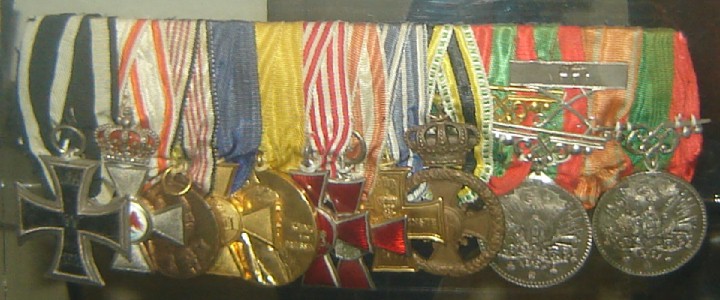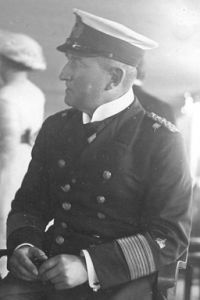| |
Bar with
the Combatants Colonial Medal and Ottoman Awards

Photo by C Dale from the Imperial War
Museum Collection The medals on this bar in order of
seniority from left to right are-
Prussian 1914 Iron Cross,
second
class
Prussian Order of the Red Eagle,
fourth class with crown
Colonial Service Medal, awarded
for taking part in the Venezuela Blockade 1902-03
Prussian Officers Long Service
Award,
for 25 years service
Prussian Wilhelm I Centenary Medal
Bremen Hanseatic Cross
Hamburg Hanseatic Cross
Schaumburg-Lippe Cross for Loyal
Service
Saxe-Meinigen Honour Cross for
Merit in War
Ottoman Imtiyaz Distinction Medal Medal,
second class in gold
with swords
Ottoman Imtiyaz Distinction Medal Medal,
first class in silver
with swords and battle clasp
Ottoman War Medal
Ottoman Imtiyaz
Distinction Medal Medal, first class in silver
without swords The original owner of this medal bar was Vizeadmiral Wilhelm Souchon, who commanded the SMS
Goeben and SMS Breslau in Ottoman service during the First World War.
His medals are worn in correct naval order of seniority with
all the Prussian awards before those of other German states
(including the ports of Bremen and Hamburg), with four
Ottoman medals in last place.
Admiral Souchon was also awarded many
other medals which do not appear on his medal bar. These awards and
the reason for their non-appearance on this medal bar are just as
interesting as those that do appear. They include the Prussian
Pour-Le Mérite (which was worn at the throat rather than on a bar),
the Prussian Iron Cross First Class and Turkish War Medal (which
were both worn on the chest); several pre-war awards from Entente
countries- Russian Order of St Anne, third Class, two Italian Orders
of the Crown and a Greek Grand Commander of the Order of the
Redeemer (which would probably have been removed as each country
sided against Germany and her allies in the war, although the Greek
order would not have been on a bar as it was like the Iron Cross,
worn on the breast and neck); several repeated awards of the
Prussian Red Eagle in different classes (which were superseded on
his bar by the one that appears there); and the Turkish Gold Liakat
Medal, Turkish Medjidie Order first class, two Saxon Albrecht Orders
(first and second class) and two Prussian Crown Order (both second
class, one with star), which he is presumably not wearing for the
simple reason of lack of space across his chest.
| |
Wilhelm Anton Souchon
(1864-1946) joined the Imperial Navy as a cadet in 1881. In
1884 he was part of the crew of the SMS Leipzig raising the
German flag over the new colony of South West Africa. He was
promoted through the officer ranks and given prestigious
commands, in 1904 he was made
Chief of Staff of the East Asian
cruiser squadron.
He was given command of the Imperial German
Mediterranean Squadron ("Mittelmeerdivision") in 1912. The
squadron consisted only of the Battlecruiser SMS Goeben and
the Light Cruiser SMS Breslau, yet their impact on the
course of the First World War went well beyond their
firepower. Winston Churchill said that by their
actions bringing the Ottoman Empire into the war, they
brought "more slaughter, more misery and more ruin than has
ever before been borne within the compass of a ship."
When war broke out
in Europe, Rear Admiral Souchon left the Austro-Hungarian
port of Pola (in modern Croatia) and led his ships to
bombard French ports in Algeria. He then dodged British
attempts to corner him and headed for Istanbul where his
ships were transferred to the Ottoman navy. It was while in
Ottoman service that they bombarded the Russian Black Sea
fleet at Sevastopol thus provoking a Russian declaration of
war and bringing the Ottoman Empire into the First World War
on Germany's side. Souchon spent the next three years
updating the Ottoman navy until recalled to Germany in
September 1917.
When the war ended
in November 1918 he had the dubious honour of commanding the
naval base at Kiel that mutinied starting the German
Revolution.
|

Admiral Wilhelm Souchon in
Istanbul 1917
Photo from
WikiCommons |
|
|